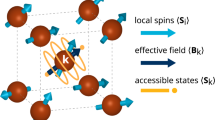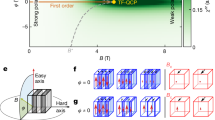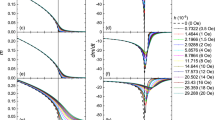Abstract
Two separate theories are often used to characterize the paramagnetic properties of ferromagnetic materials. At temperatures T well above the Curie temperature, TC (where the transition from paramagnetic to ferromagnetic behaviour occurs), classical mean-field theory1 yields the Curie–Weiss law for the magnetic susceptibility: χ( T) ∝ 1/(T - Θ), where Θ is the Weiss constant. Close to TC, however, the standard mean-field approach breaks down so that better agreement with experimental data is provided by critical scaling theory2,3: χ(T) ∝ 1/(T - TC)γ, where γ is a scaling exponent. But there is no known model capable of predicting the measured values of γ nor its variation among different substances4. Here I use a mean-field cluster model5 based on finite-size thermostatistics6,7 to extend the range of mean-field theory, thereby eliminating the need for a separate scaling regime. The mean-field approximation is justified by using a kinetic-energy term to maintain the microcanonical ensemble8. The model reproduces the Curie–Weiss law at high temperatures, but the classical Weiss transition at TC = Θ is suppressed by finite-size effects. Instead, the fraction of clusters with a specific amount of order diverges at T C, yielding a transition that is mathematically similar to Bose–Einstein condensation. At all temperatures above TC, the model matches the measured magnetic susceptibilities of crystalline EuO, Gd, Co and Ni, thus providing a unified picture for both the critical-scaling and Curie–Weiss regimes.
This is a preview of subscription content, access via your institution
Access options
Subscribe to this journal
Receive 51 print issues and online access
$199.00 per year
only $3.90 per issue
Buy this article
- Purchase on Springer Link
- Instant access to full article PDF
Prices may be subject to local taxes which are calculated during checkout


Similar content being viewed by others
References
Weiss, P. L'hypothèse du champ moleculaire et la propriéte ferromagnetique. J. Phys. (Paris) 6, 661– 690 (1907).
Stanley, H. E. Introduction to Phase Transitions and Critical Phenomena (Oxford Univ. Press, New York, 1971).
Stanley, H. E. Scaling universality, and renormalization. Rev. Mod. Phys. 71, S358–S366 (1999).
Collins, M. F. Magnetic Critical Scattering (Oxford Univ. Press, New York, 1989).
Chamberlin, R. V. Mesoscopic mean-field theory for supercooled liquids and the glass transition. Phys. Rev. Lett. 82, 2520– 2523 (1999).
Hill, T. L. Thermodynamics of Small Systems Parts I and II (Dover, New York, 1994).
Hill, T. L. & Chamberlin, R. V. Extension of the thermodynamics of small systems to open metastable states: An example. Proc. Natl Acad. Sci. USA 95, 12779–12782 (1998).
Creutz, M. Deterministic Ising dynamics. Ann. Phys. 167, 62–72 (1986).
Rowlinson, J. S. Legacy of van der Waals. Nature 244, 414 –417 (1973).
Onsager, L. Crystal statistics I. A two-dimensional model with an order-disorder transition. Phys. Rev. 65, 117–149 (1944).
Guggenheim, E. A. The principle of corresponding states. J. Chem. Phys. 13, 253–261 (1945).
Wegner, F. J. Corrections to scaling laws. Phys. Rev. B 5, 4529–4536 (1972).
Souletie, J. & Tholence, J. L. Critical behavior of nickel between TC and 3TC. Solid State Commun. 48, 407–410 (1983).
Smart, J. S. Effective Field Theories of Magnetism (Saunders, Philadelphia, 1966).
Huang, K. Statistical mechanics 2nd edn (Wiley, New York, 1987 ).
Chamberlin, R. V. & Holtzberg, F. Remanent magnetization of a simple ferromagnet. Phys. Rev. Lett. 67, 1606–1609 (1991).
Korenman, V. Theories of itinerant magnetism. J. Appl. Phys. 57, 3000–3005 (1985).
Mezei, F., Farago, B., Hayden, S. M. & Stirling, W. G. Breakdown of conventional dynamic scaling at the ferromagnetic Curie point in EuO. Physica B 156&157, 226– 228 (1989).
Schiener, B., Böhmer, R., Loidl, A. & Chamberlin, R. V. Nonresonant spectral hole burning in the slow dielectric response of supercooled liquids. Science 274, 752– 754 (1996).
Chamberlin, R. V. Nonresonant spectral hole burning in a spin glass. Phys. Rev. Lett. 83, 5134–5137 ( 1999).
Chamberlin, R. V. Experiments and theory of the nonexponential relaxation in liquids, glasses, polymers and crystals. Phase Transitions 65, 169–209 (1998).
Bally, D., Popovici, M., Totia, M., Grabcev, B. & Lungu, A. M. Small-angle critical magnetic scattering of neutrons in Co. Neutron Inelastic Scattering Vol. II, 75–82 (IAEA, Vienna, 1968).
Menyuk, N., Dwight, K. & Reed, T. B. Critical magnetic properties and exchange interactions in EuO. Phys. Rev. B 3, 1689– 1698 (1976).
Huang, C. C. & Ho, J. T. Faraday rotation near the Curie point of EuO. Phys. Rev. B 12, 5255– 5260 (1975).
Arajs, S. & Colvin, R. V. Paramagnetism of polycrystalline gadolinium, terbium, and dysprosium metals. J. Appl. Phys. 32, 336S–337S (1961).
Nigh, H. E., Legvold, S. & Spedding, F. H. Magnetization and electrical resistivity of gadolinium single crystals. Phys. Rev. 132, 1092– 1097 (1963).
Geldart, D. J. W., Hargraves, P., Fujiki, N. M. & Dunlap, R. A. Anisotropy of the critical magnetic susceptibility of gadolinium. Phys. Rev. Lett. 62, 2728–2731 (1989).
Nakagawa, Y. Change of magnetic susceptibility of transition metals and alloys at their melting points. J. Phys. Soc. Jpn. 11, 855 –863 (1956).
Colvin, R. V. & Arajs, S. Magnetic susceptibility of face-centred cubic cobalt just above the ferromagnetic Curie temperature. J. Phys. Chem. Solids 26, 435–437 (1965).
Fallot, M. Paramagnétisme des èléments ferromagnétiques. J. Phys. (Paris) 8, 153– 163 (1944).
Arajs, S. Paramagnetic behavior of nickel just above the ferromagnetic Curie temperature. J. Appl. Phys. 36, 1136– 1137 (1965).
Acknowledgements
I thank K. E. Schmidt and G. H. Wolf for several insights into the subject reported here. I also thank B. Geil, T. L. Hill, S. M. Lindsay and R. Richert for discussions. This work was supported by the NSF.
Author information
Authors and Affiliations
Corresponding author
Rights and permissions
About this article
Cite this article
Chamberlin, R. Mean-field cluster model for the critical behaviour of ferromagnets. Nature 408, 337–339 (2000). https://doi.org/10.1038/35042534
Received:
Accepted:
Issue Date:
DOI: https://doi.org/10.1038/35042534
This article is cited by
-
Organic radical ferroelectric crystals with martensitic phase transition
Nature Communications (2023)
-
Theoretical description of the magnetocaloric effect in Pr0.67Sr0.33MnO3 manganite using the mean-field theory
Applied Physics A (2023)
-
\(\mu PT\) statistical ensemble: systems with fluctuating energy, particle number, and volume
Scientific Reports (2021)
-
Modeling of Magnetic and Magnetocaloric Properties by the Molecular Mean Field Theory in La0.6Sr0.4Mn0.9V0.1O3 Oxide
Journal of Superconductivity and Novel Magnetism (2021)
-
Thermodynamics of CuPt nanoalloys
Scientific Reports (2018)
Comments
By submitting a comment you agree to abide by our Terms and Community Guidelines. If you find something abusive or that does not comply with our terms or guidelines please flag it as inappropriate.



